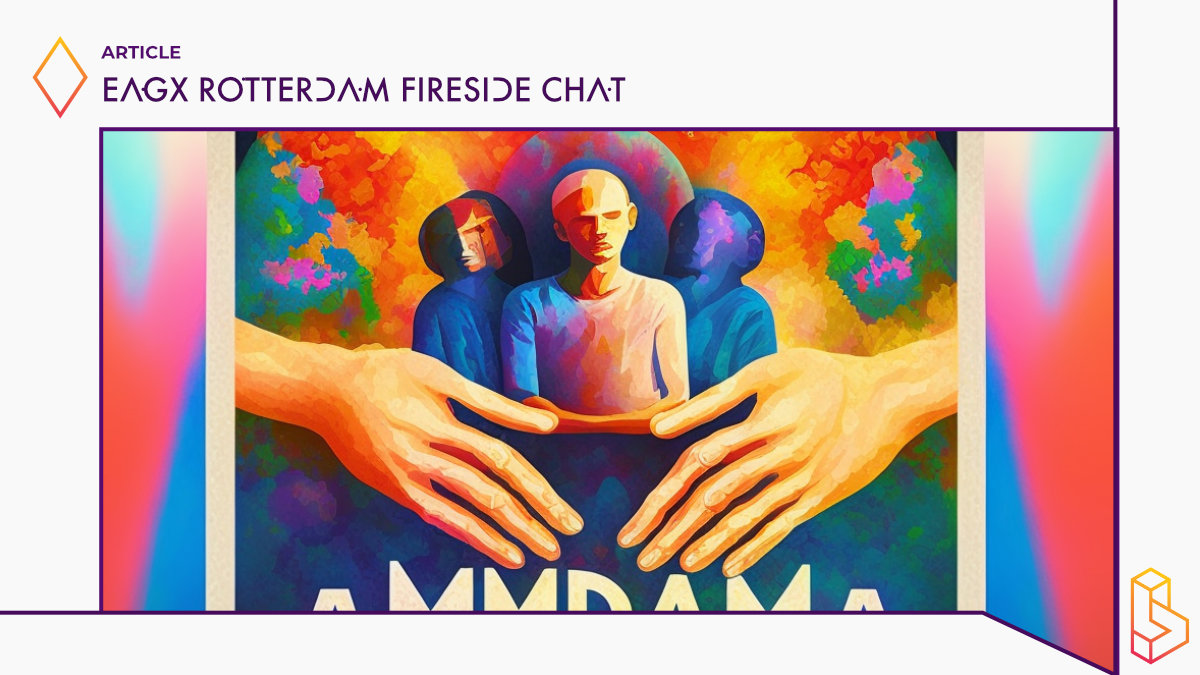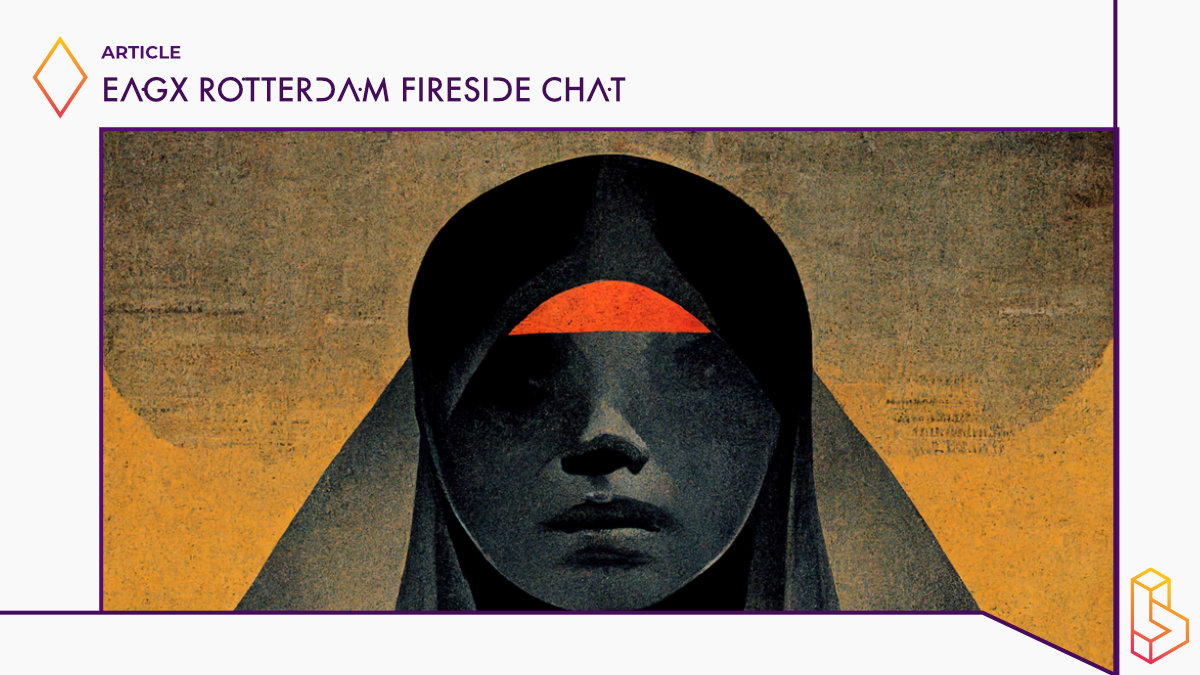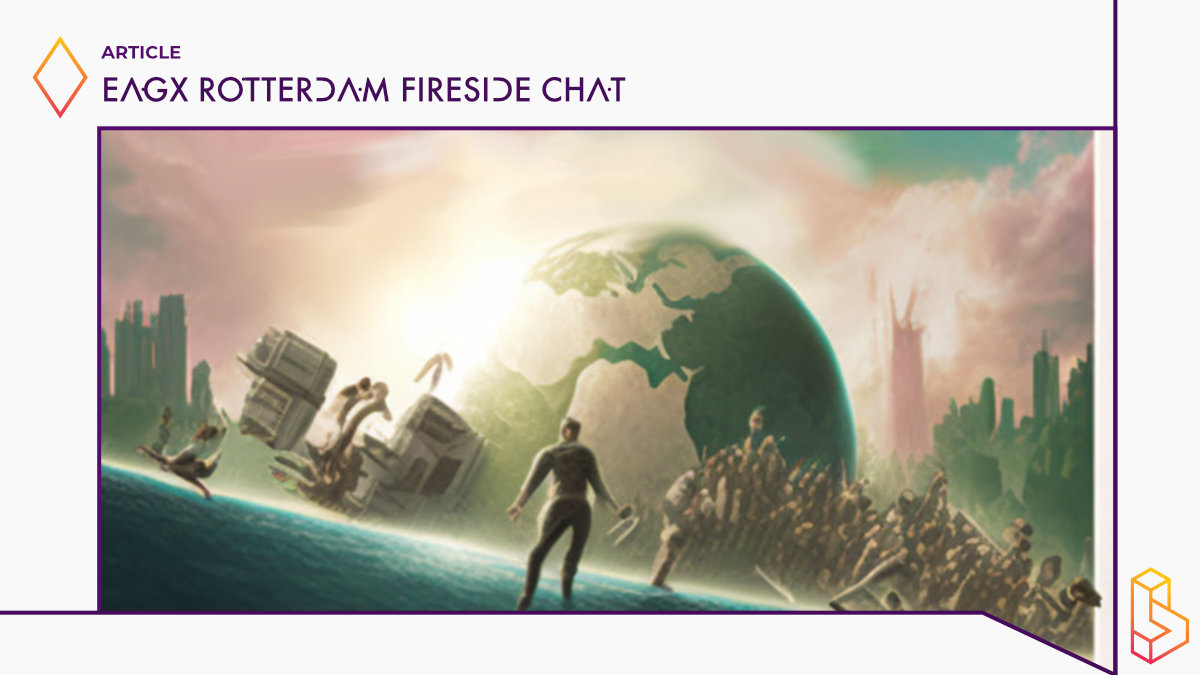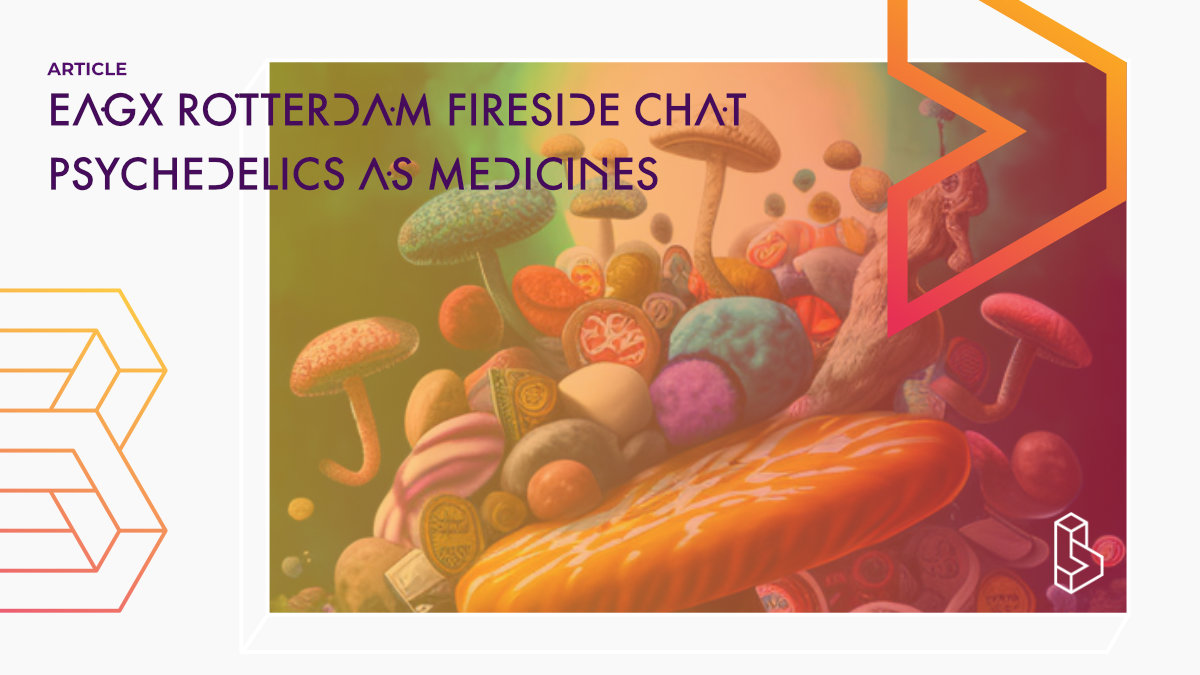This post is an edited/prepared transcript of a conversation about psychedelics as medicines between Floris Wolswijk and Ingvild Syntropia at EAGx Rotterdam (an independently organised Effective Altruism conference) in November 2022.
What are psychedelics anyway?
Ingvild: Hey Floris, pretend for a second that I know nothing about psychedelics. Can you explain to me what psychedelics are?
Floris: Psychedelics are substances that change how you experience the world. Do you have experience with drinking coffee?
I: Yes, I’ve drunk my fair share of coffee.
F: Awesome, then you have experience with psychoactive substances. Coffee – specifically caffeine – changes how the cells in your brain – called neurons – communicate. A signal that normally says – I’m sleepy – gets turned down, and you feel more awake and focused.
I: I can relate to that, but what does this have to do with psychedelics?
F: Psychedelics do something similar, but also different. Instead of feeling alert, psychedelics – at sufficient doses – radically change every aspect of how you experience the world.
For the purpose of this talk, psychedelics include classical psychedelics such as psilocybin (which is the pro-drug of psilocin – and can be found in magic mushrooms or truffles here in The Netherlands), LSD, mescaline, and DMT (which is an integral part of the ayahuasca brew), empathogens (for instance, MDMA), and dissociatives (for instance, ketamine).
Effects of psychedelics can include seeing moving patterns in a normally blank white wall, feeling filled with joy from your toes to the tip of your head, or losing all perception of your body.
The different classes of psychedelics achieve these effects in different ways. Classical psychedelics interact with the serotonergic brain system. We have a limited amount of time, so I can’t give you a heroic dose of information. For now, it’s good to know that the acute effects range from 15 minutes to a full day. For many people, the psychedelic experience is enjoyable, but there are notable exceptions and also risks associated with their use of them.
Psychedelic Science – A quick history lesson
I: Thank you for that introduction. You’re here today to talk about the use of psychedelics as medicine. How do we go from something that modifies our experience to seeing this as medicine?
F: Psychedelics have been used as a medicine within the indigenous context for as long as we have a history. Cave paintings from thousands of years ago depict humans covered with mushrooms. To say that psychedelics as medicine has been invented by some American-, Swiss-, and UK-based men in lab coats would not be correct. But that is where I will focus my attention when covering the medical use of psychedelics.
Psychedelics became enormously popular in the 60s and 70s when those in the counter-culture embraced them. Psychedelic evangelist Timothy Leary famously said: turn on, tune in, drop out. He was a professor at Harvard, but after discovering psychedelics, he became increasingly irresponsible and gave them at huge doses to undergraduate students. He was not solely responsible for outlawing psychedelics but did contribute greatly to the downfall of psychedelic science in the late 60s.
To know how psychedelics are turning into medicines, we must go back one more decade. Research into psychedelics began in the 50s when Sandoz – the lab where Albert Hofmann discovered LSD – started shipping LSD and psilocybin to anyone who could show credentials. Psychiatrists took LSD to try and understand the psyche of their patients – at that time, they called it a psychomimetic – mimicking psychosis. But we now know that although there are similarities, a psychedelic state is much different from psychosis.
Some of the research done before the eventual prohibition in 1966 included giving psychedelics to alcoholics. The theory of change was similar to that of the ‘scared straight’ programme. Give them such a harrowing experience, that they would be shocked out of their alcoholism. But, even without a proper set & setting, many of the participants enjoyed the experience. The outcome of the study showed a reduction in alcoholism.
Later analysis of the data, remember this is the science from 60 years ago, showed no significant change in alcoholism. But this signal, and others around the lowering recidivism rate of prisoners, and successes with using MDMA in relationship therapy, showed a promising way forward for psychedelics.
I: You mention set & setting. Can you elaborate on that?
F: Set and setting refer to the internal mindset of the person and the external environment where the trip takes place. Giving a high dose of LSD within a medical ward will lead to a completely different trip versus doing it outside next to a blossoming tree. Similarly, if a person is dealing with a lot of stress, the trip might reflect this and be more stressful than someone who comes in relaxed.
This is also why much research focuses on creating a therapeutic container. By this, I mean that participants generally learn about what the psychedelic experience will be like and that they will be in the safe hands of the therapists. Commonly, people don’t experience ‘bad’ trips if the set & setting are right, though it may be challenging. I think we will cover that in a bit.
I: It’s interesting to learn how psychedelic research got started. What about the research taking place right now, also called the psychedelic renaissance?
F: In total, more than 400 clinical trials have been started in the last two decades, of which most are taking place within the last few years. Half of these studies focus on depression, with PTSD and addiction being the next two on the list.
This is just describing the clinical trials. Outside of that, many more naturalistic studies, surveys, and other good research has come out. In total, I’ve covered over 1600 papers on Blossom.
Also good to know is that psychedelics are being investigated for over 22 different topics or indications. These range from cluster headaches and fibromyalgia (central nervous system pain), to opioid addiction and smoking.

MAPS showcase – MDMA-assisted therapy
I: It’s encouraging to see so much research happening now. Can we dive into one of these? I know that MAPS – a non-profit organisation that has been working on psychedelics as medicines for the last 35 years – is advancing MDMA in combination with therapy through the clinical trial process. Can you tell me more about MDMA-assisted therapy by MAPS?
F: MAPS itself is already quite a unique organisation – it’s not common for a non-profit to take a medicine through clinical trials. One reason – of many – for big pharma not to lead this field is that the molecules themselves – including MDMA – are either naturally occurring or are off-patent. In other words, there is no big money to be made from the medicines themselves.
Let me focus on the therapeutic protocol that MAPS has developed. Participants will receive talk therapy – for instance, Cognitive Behavioural Therapy – for a total of 12 sessions. The non-psychedelic sessions last for 1,5 hours, whilst three of the sessions are with MDMA and take a full workday. During the MDMA-assisted session, participants get one high dose – comparable to a recreational dose – and a half-dose booster after a few hours.
I: That sounds like a very involved protocol. I know that the participants in these trials have suffered from PTSD for a long time. Is there hope for them?
F: That is correct. They have been walking around with PTSD for an average of 15 years. After the treatment, two-thirds of them no longer qualify for a PTSD diagnosis.
And this effect holds up. A year later, without continued support from MAPS, and with almost none of the participants seeking out MDMA themselves, two-thirds remain without clinical symptoms of PTSD – this is called remission.
I should note that one-third of the participants in the non-MDMA but with therapy group also are in remission. In other words, they are treated by highly qualified therapists and receive care beyond what they are used to.
I: Wow, that sounds amazing. Before we examine these findings’ rigour, can you talk a bit more about how this experience is for participants?
F: There are many aspects that people report improving on. This ranges from self-compassion to feeling more connected with everything around them. I’ve printed out a statement from one of the participants about connection and self-compassion.
[An improvement is] just being able to communicate what I’m going through with people. Up until I finished the MDMA therapy, I was never able to communicate with anybody in my day-to-day life about any of the issues that I was going through. Really not friends, not family…. I feel like I can be more open with people now. It was that first MDMA session that we had, where I had that breakthrough, where I could clearly see that I had a big disconnect in compassion for myself.
I: We’ve discussed many positive and promising aspects of psychedelics as medicine. Could you talk a bit about the potential risks?
F: Changing how you experience the world doesn’t come without risks. Generally, psychedelics improve well-being, but for some, it could trigger a psychotic episode if that runs in the family. Psychedelic use may also lead to flashbacks after the acute experience. This is called Hallucinogenic Persistent Perception Disorder (HPPD) and can seriously influence someone’s life. For participants in clinical trials, flashbacks happened to 10%, but were mild and experienced as neutral or pleasant.
One big worry – something to preempt – is that patients undergoing psychedelic-assisted therapy are more vulnerable to abuse. You are in a more open and suggestible state. There is good reporting of an inappropriate relationship forming between a therapist and a participant in the MDMA trial we just talked about. Similarly, there are many stories of abuse by shamans, sitters, and guides. Being a psychedelic-inclined person who guides sessions doesn’t make you a saint.
Another thing to note is that you practically can’t overdose on psychedelics. At a sufficient dose, one might feel like they are dying, but some people have accidentally done 550x too much LSD and have lived to tell the tale.

Panacea or for the Privileged
I: Okay, you’ve introduced us to psychedelics’ history, pros and cons. What are the costs of conducting research, the legalisation process, and administering it to participants and patients?
F: “It’s tough to make predictions, especially about the future”, Yogi Berra famously said. What we know now is that the cost of a full course of (MDMA) psychedelic-assisted therapy comes in at around $15k. This is mostly based on the hours a therapist is there – remember: the current molecules themselves are not patentable. There are ways that this cost could go lower by having only one therapist during the drug-assisted session instead of two.
But even in the current paradigm, the savings to society per year that someone doesn’t walk around with severe depression stand at $20k. There is still a long way to go to convince payers – insurance companies – but the first signs are there, with ketamine-assisted therapy being reimbursable in some cases.
This is the individual cost. The amount of money that has been pumped into research stands at around $1 billion (data from Psychedelic Alpha). On the one hand, this is a massive amount of money. On the other hand, a pharma company spends about this amount to get one drug to market.
I: There seems to be lots of enthusiasm around psychedelic research, but could this be hype? For example, could the promising results be explained by mostly working with motivated or biased participants?
F: Yes (dramatic pause). There is a considerable chance that the overwhelmingly positive results from clinical trials will not hold up when psychedelics become a treatment that is generally available.
The results from Phase I and II trials usually don’t see the same effect in Phase III and IV trials – post-market surveillance. Participants in the studies are highly motivated to show positive results, there are strict exclusion criteria, the therapists are world-class, and it’s safe to say that everyone in the field is biased towards positive outcomes (me included). Where else do you see that the medicine you’re developing is being used by researchers themselves recreationally, possibly even mere hours after a very serious research conference ends?
This doesn’t mean there is no chance the results will hold up. The first large-scale studies on ketamine-assisted therapy in the real world have come out. These report very similar rates of remission as the clinical trials.
I: That’s very interesting, and a good perspective. So what are some reasons for hope regarding psychedelics as medicine?
F: Psychedelics may provide relief for many of the 1.3 billion people with mental health, addiction, or pain disorders. If we focus on chronic mental health conditions, we are talking about 300 million people that can be helped.
Are psychedelics as medicine effective?
I: 300m people, that’s a lot! Can this be something the effective altruism community could support?
For all the sources and a longer analysis, see my post on Psychedelics through the lens of EA
F: Maybe. I think we – as the EA community – can look a lot closer at this area. And by this area, I mean the places where psychedelics can be helpful. If we see psychedelics as a multifunctional tool, we may see it being applied to many different areas, from chronic mental health to addiction treatment.
I’ve analysed – using the framework from 80k – with a focus on chronic mental health and ‘scored’ psychedelics as medicine 21 out of 36. This is on the lower end of the (effective) causes within the EA framework.
I: Can you tell me more about how mental health is a neglected area?
F: This is me speaking outside my expertise, but investments in mental health are generally lacking. Much of the research dollars are going towards ‘understanding’ the brain and not enough on executing or improving therapy.
That is in the Western world. If we look beyond that, we see that in many places, there are virtually no mental health services. Some places have fewer than one mental health worker in 100.000 inhabitants.
In general, we don’t spend enough on mental health and have a minimal understanding of how to treat chronic mental health issues, for which psychedelics may be a partial solution.
I: Alright, so mental health is a somewhat neglected area. What about its importance according to EA metrics?
F: 10% of the world population is currently dealing with mental health disorders – this is from Our World in Data. We spend billions on treatments, and many interventions have a very good return on investment (for instance, StrongMinds). Each year, chronic mental health issues lead to 40 million DALYs. If we include chronic pain and addiction, the number grows much higher.
I: Wow, that is a huge scale, but is it solvable? What if we doubled our effort? What impact do you think it will have?
Pouring more money, time, and effort into mental health treatments will be helpful. Scaling up psychedelic treatments, barring a total lack of efficacy in large-scale real-world trials, would certainly have more than a 10% chance of helping solve chronic mental health issues for each person undergoing these treatments.
This is also where I diverge a bit from the 2019 Founders Pledge report on psychedelics, where they estimate the improvement in mental health to be relatively minor. Their analyses were done when fewer data were available, and psychedelic-assisted treatment seemed to hold up better than expected.

What can I, an EA-aligned person, do?
I: Interesting. So, where do psychedelics fit within the EA community? What can you do in terms of studies or career if you want to combine your EA values with an interest in psychedelics as medicine?
F: The EA/80k cause prioritisation framework has a fourth factor I think all of you know about – personal fit. Is it something that interests you? Do you have specific skills and knowledge that would help? Can you build career capital whilst working in this field?
What is acutely needed is a metric boatload of therapists. Each individual therapist expects to only work with 40 to 80 clients annually – or one to two per week. Let me explain, the drug-assisted sessions are very intense for therapists too. To treat 100.000 people, you would need around 2000 therapists. Training programs have been around for some years, and they are scaling up, but if you are a therapist, counsellor, or otherwise qualified mental health worker – becoming a licenced psychedelic therapist may be a very impactful job. But still, here, it is the question of what insurance companies/healthcare systems will be willing to accept and pay for.
For studies, psychology or medicine would be the most obvious. As in every industry, operations are also crucial. And in terms of other jobs, lobbying governments to change regulations is ramping up. Getting psychedelics to patients one year earlier could have a significant impact.
You can find the current jobs listed on Psychedelic Alpha, a talent pool will also be added within the next few weeks, where you can leave your details.
I: What are some next steps people can take if they want to learn more?
F: I skipped over so much to give you this microdose of psychedelic info in 40 minutes, but I will be around for office hours after the Q&A right after this.
If you want to dive deeper into the research, most resources on Blossom are free to use.
I recommend the Psychedelic Handbook by Rick Strassman and How to Change Your Mind by Michael Pollan – the latter has also been adapted into a four-part Netflix series. For both books, you can find summaries on Blossom.
Become a psychedelic insider
Get a Pro Membership to enjoy these benefits & support Blossom📈 full reports on Topics & Compounds
🧵 full summary reviews of research papers
🚀 full access to new articles
See Memberships

